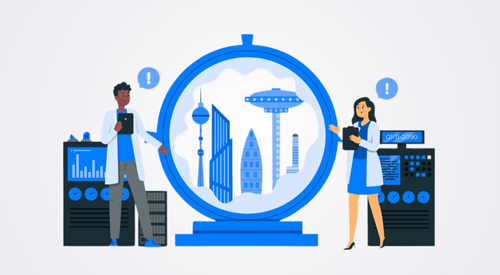

As organizations increasingly rely on virtual machines (VMs) to power their critical workloads, the need for robust disaster recovery (DR) solutions has never been greater. Enter Google Cloud DR solutions, a comprehensive suite of must-have offerings that provide a lifeline for businesses seeking to safeguard their operations against unforeseen disruptions. In this blog, we delve into the realm of Google Cloud solutions for VM Disaster Recovery and Backup, exploring the intricacies of designing, implementing, and managing a resilient infrastructure that withstands the tides of adversity.
Safeguard Your Virtual Machines with Google Cloud
With a focus on continuity and resilience, Google Cloud stands as a stalwart guardian, empowering businesses to navigate the turbulent waters of disaster with confidence. From choosing primary and DR sites to replicating databases and automating DR drills, we will take you through the landscape of continuity, where Google Cloud serves as the beacon of reliability in an ever-changing digital world.
Enhanced Tooling for GCP Disaster Recovery
GCP provides a suite of tools to enhance disaster recovery (DR):
- Expert Guidance: Access to experts for resilient architecture design.
- VM Backup and Disaster Recovery: Native tools like VM snapshots and regional redundancy for rapid recovery.
- GKE Redundancy: Deploy multi-cluster architectures for fault tolerance.
- Managed Database Solutions: Built-in redundancy and failover for data availability.
- Gateways and Ingress: Distribute traffic and facilitate failover for improved resiliency.
- Partner Solutions: Additional DR solutions available in the GCP Marketplace, integrating seamlessly with GCP services.
By leveraging GCP’s tools and partner ecosystem, you can implement resilient architectures, automate DR processes, and ensure business continuity.
VM Disaster Recovery Explored
GCP offers powerful tools for VM backup and disaster recovery:
- VM Multi-regional Snapshots: Create efficient backups of VM disks across multiple regions, enabling swift restoration to previous states in case of data corruption or disasters.
- Multiregional Redundancy for MIGs: Distribute VM instances across regions for proactive redundancy, minimizing service disruptions and downtime during infrastructure failures.
- Automated Backup and DR Policies: Establish automated policies for scheduled backups, customizing frequency and retention periods. GCP streamlines the backup process, ensuring data protection and availability.
With GCP’s native tools, organizations can protect their VM-based workloads and ensure business continuity, leveraging features like VM snapshots and automated backup policies.
Choosing Primary Site and DR Site/Region
Choosing the primary site and disaster recovery (DR) site/region is a crucial decision in disaster recovery planning. It involves careful consideration of various factors to ensure resilience and continuity in the event of a disruptive incident. Let’s explore each aspect in detail:
Primary Site: The primary site is the location where the organization’s primary IT infrastructure, including servers, applications, and databases, resides. This site hosts the live production environment that supports day-to-day business operations. When selecting the primary site, organizations typically prioritize factors such as proximity to users or customers, network connectivity, and accessibility.
Key considerations for choosing the primary site include:
- Proximity to Users: The primary site should be located close to the majority of users or customers to minimize latency and ensure optimal performance.
- Network Connectivity: Robust network connectivity is essential for seamless communication between users, applications, and data sources. The primary site should have high-speed, reliable internet connectivity and redundant network connections to prevent downtime.
- Accessibility and Security: The primary site should be easily accessible to authorized personnel for maintenance, monitoring, and management. It should also have adequate physical security measures in place to protect against unauthorized access and potential threats.
Secondary or DR Site/Region: The secondary site, also known as the disaster recovery (DR) site or region, serves as a backup location where critical IT infrastructure and data are replicated or backed up to ensure continuity in case of a disaster at the primary site. Selecting the DR site involves assessing various factors to ensure geographic diversity, redundancy, and resilience.
Key considerations for choosing the secondary or DR site/region include:
- Geographic Diversity: The DR site should be located in a geographically separate region from the primary site to mitigate the risk of simultaneous disruptions caused by natural disasters, geopolitical events, or other localized incidents.
- Redundancy and Resilience: The DR site should have redundant infrastructure, including servers, storage, and networking components, to ensure resilience and availability. It should also have its own power supply, internet connectivity, and environmental controls to operate independently of the primary site
- Data Replication and Synchronization: Data replication mechanisms, such as synchronous or asynchronous replication, should be implemented to ensure that data is continuously mirrored or backed up to the DR site in real-time or at predefined intervals.
- Failover and Failback Capabilities: The DR site should have the ability to quickly failover to become the primary site in the event of a disaster, as well as the capability to failback to the primary site once it’s restored to normal operations.
By carefully evaluating these factors and selecting appropriate primary and DR sites, organizations can establish a resilient and robust infrastructure that minimizes the impact of disruptions and ensures continuity of business operations.
Ensuring Connectivity Between Primary Site and DR
Ensuring connectivity between the primary site and the disaster recovery (DR) site is crucial for maintaining continuous operations and seamless failover in the event of a disaster. A robust and reliable network infrastructure is essential to facilitate data replication, synchronization, and failover processes. Here’s a detailed section on ensuring connectivity between the primary site and DR:
To ensure seamless connectivity between primary and disaster recovery (DR) sites:
- High-Speed, Redundant Connectivity: Equip both sites with redundant network connections to mitigate the risk of outages.
- VPNs or Direct Interconnect: Implement secure VPNs or direct interconnect services for reliable data transmission.
- QoS and Traffic Prioritization: Prioritize critical data traffic using QoS mechanisms to optimize network performance.
- WAN Optimization: Utilize WAN optimization techniques to enhance data transfer efficiency and reduce latency.
- Redundant Routing and Failover: Configure redundant routing and failover mechanisms for automatic traffic rerouting during network failures.
- Monitoring and Alerting: Implement proactive network monitoring to identify and resolve connectivity issues in real-time, minimizing downtime.
By implementing these strategies and best practices, organizations can establish a resilient and reliable network infrastructure that ensures seamless connectivity between the primary site and DR site, enabling effective disaster recovery and business continuity planning.
Google Cloud Disaster Recovery Solutions: Types of DR Strategies
Disaster recovery (DR) strategies come in various forms, each tailored to meet specific business requirements and objectives. Two common types of DR configurations are warm DR (active-passive) and hot DR (active-active). Let’s explore each type in detail:
- Warm DR (Active-Passive): Warm DR, also known as active-passive DR, involves maintaining a standby environment (DR site) that is partially configured and ready to take over operations in the event of a disaster. However, unlike hot DR, the standby environment in a warm DR setup is not actively processing live production workloads.
In a warm DR configuration:
- The primary site hosts the live production environment, processing all incoming transactions and serving end-users.
- The DR site serves as a backup location where critical data and infrastructure components are replicated or mirrored, but no active processing of transactions occurs.
- When a disaster occurs at the primary site, failover procedures are initiated to redirect traffic and workload to the DR site.
- The DR site becomes active, assuming the role of the primary site and restoring normal operations until the primary site is restored.
Warm DR offers a balance between cost-effectiveness and recovery time objectives (RTOs) by maintaining a standby environment without the need for continuous synchronization of data and resources. It is suitable for applications and workloads with moderate RTO requirements and where the cost of downtime outweighs the cost of maintaining a fully active DR environment.
- Hot DR (Active-Active): Hot DR, also known as active-active DR, involves maintaining two fully operational and synchronized environments, with both sites actively processing live production workloads simultaneously. This setup ensures high availability and minimal downtime by distributing workloads across multiple locations in real-time.
In a hot DR configuration:
- Both the primary site and the DR site are fully configured and actively processing transactions, serving end-users concurrently.
- Data replication and synchronization mechanisms ensure that changes made to the primary site are mirrored or replicated to the DR site in real-time or near-real-time.
- In the event of a disaster or failure at one site, traffic is automatically rerouted to the remaining operational site without disruption to end-users.
- Workloads continue to be processed seamlessly, ensuring business continuity and meeting stringent RTO and recovery point objective (RPO) requirements.
- Hot DR offers the highest level of resilience and availability, making it ideal for mission-critical applications and workloads with stringent RTO and RPO requirements. However, it typically involves higher infrastructure and operational costs due to the need for redundant resources and continuous synchronization of data.
In summary, organizations must carefully evaluate their business needs, recovery objectives, and budget constraints when selecting between warm DR (active-passive) and hot DR (active-active) configurations to ensure optimal disaster recovery preparedness and resilience.
Setting Up a DR Strategy
In disaster recovery (DR) planning:
- Infrastructure and Application Design: Ensure resilience by identifying critical systems, defining recovery objectives, and designing failover procedures considering factors like network connectivity and resource availability.
- Backup and Restore for Stateful Apps: Implement backup mechanisms capturing real-time changes to maintain data integrity and consistency during recovery, minimizing data loss.
- Database Replication: Continuously replicate critical data to the DR site using techniques like synchronous or asynchronous replication for seamless failover and minimal data loss.
- Automating DR Drills: Use DR run books to automate drills, validating and improving DR plans regularly to streamline recovery efforts, minimize errors, and enhance response times during disasters.
- Stakeholder Management: Identify key stakeholders, establish clear communication channels, and define roles using RACI matrices to foster collaboration, enhance decision-making, and ensure a unified approach to DR across the organization.
Conclusion – Recover Faster and Better
In conclusion, effective disaster recovery (DR) planning and implementation are indispensable components of modern business resilience strategies. As organizations increasingly rely on digital infrastructure and data-driven processes, the ability to quickly recover from disruptive incidents becomes paramount. Through meticulous DR design and planning, including infrastructure and application considerations, robust backup and restore mechanisms, database replication strategies, and the automation of DR drills, businesses can mitigate the impact of disasters and ensure continuity of operations. Additionally, stakeholder management and the use of RACI matrices help foster collaboration and accountability, facilitating a cohesive response to disasters. By prioritizing DR preparedness and embracing best practices, organizations can safeguard their assets, maintain customer trust, and thrive in the face of adversity.









